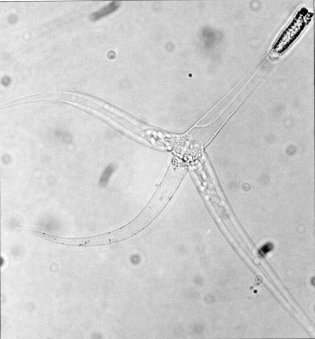Myxozoa
Appearance
| Myxozoa | |
|---|---|

| |
| Triactinomyxon stage of Myxobolus cerebralis. | |
| Scientific classification | |
| Kingdom: | |
| Phylum: | |
| (unranked): | Myxozoa Grassé, 1970
|
| Classes | |
The Myxozoa [1] are a group of parasitic animals of aquatic environments. Some of them, such as Myxobolus cerebralis, are important parasites of fishes that people eat.
Over 1300 species have been described and many have a two-host life cycle, involving a fish and an annelid worm or bryozoan.
They were once considered as parasitic protozoa, but are now known to be members of the phylum Cnidaria. Analysis of 50 coding genes from Buddenbrockia showed the Myxozoa were severely modified members of the Cnidaria.
Similarities between myxozoan 'polar capsules' and cnidarian nematocysts (stinging cells) had been known for a long time, but previously were thought to be the result of convergent evolution.[2][3]
References
[change | change source]- ↑ from Greek myx- = slime or mucus + zoa = animals
- ↑ E. Jímenez-Guri; et al. (July 2007). "Buddenbrockia is a cnidarian worm". Science. 317 (116): 116–118. Bibcode:2007Sci...317..116J. doi:10.1126/science.1142024. PMID 17615357. S2CID 5170702.
- ↑ Kent M.L., Margolis L. & Corliss J.O. 1994. The demise of a class of protists: taxonomic and nomenclatural revisions proposed for the protist phylum Myxozoa Grasse, 1970. Canadian Journal of Zoology 72(5):932-937.